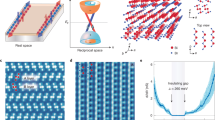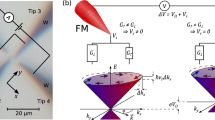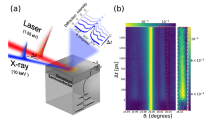Abstract
Topological insulators are bulk semiconductors that manifest in-gap surface states with massless Dirac-like dispersion due to the topological bulk-boundary correspondence principle1,2,3. These surface states can be manipulated by the interface environment to display various emergent phenomena4,5,6,7,8,9,10,11. Here, we use angle-resolved photoemission spectroscopy and scanning tunnelling microscopy to investigate the interplay of crystallographic inhomogeneity with the topologically ordered band structure in a model topological insulator. We develop quantitative analysis methods to obtain spectroscopic information, in spite of a limited dwell time on each measured point. We find that the band energies vary on the scale of 50 meV across the sample surface, and this enables single sample measurements that are analogous to a multi-sample doping series. By focusing separately on the bulk and surface electrons we reveal a hybridization-like interplay between fluctuations in the surface and bulk state energetics.
This is a preview of subscription content, access via your institution
Access options
Access Nature and 54 other Nature Portfolio journals
Get Nature+, our best-value online-access subscription
$29.99 / 30 days
cancel any time
Subscribe to this journal
Receive 12 print issues and online access
$209.00 per year
only $17.42 per issue
Buy this article
- Purchase on Springer Link
- Instant access to full article PDF
Prices may be subject to local taxes which are calculated during checkout




Similar content being viewed by others
Code availability
All relevant source code or algorithms are available from the corresponding author upon reasonable request.
References
Hasan, M. Z. & Kane, C. L. Colloquium: topological insulators. Rev. Mod. Phys. 82, 3045–3049 (2010).
Qi, X.-L. & Zhang, S.-C. Topological insulators and superconductors. Rev. Mod. Phys. 83, 1057–1067 (2011).
Fu, L., Kane, C. L. & Mele, E. J. Topological insulators in three dimensions. Phys. Rev. Lett. 98, 106803 (2007).
Qi, X.-L. et al. Inducing a magnetic monopole with topological surface states. Science 323, 1184–1187 (2009).
Fu, L. & Kane, C. L. Superconducting proximity effect and Majorana fermions at the surface of a topological insulator. Phys. Rev. Lett. 100, 096407 (2008).
Wray, L. A. et al. Observation of topological order in a superconducting doped topological insulator. Nat. Phys. 6, 855–859 (2010).
Xu, Y. et al. Disorder enabled band structure engineering of a topological insulator surface. Nat. Commun. 8, 14081 (2017).
Miao, L. et al. Observation of a topological insulator Dirac cone reshaped by non-magnetic impurity resonance. npj Quantum Mater. 3, 29 (2018).
Alpichshev, Z. et al. STM imaging of impurity resonances on Bi2Se3. Phys. Rev. Lett. 108, 206402 (2012).
Alpichshev, Z. et al. STM imaging of electronic waves on the surface of Bi2Te3: topologically protected surface states and hexagonal warping effects. Phys. Rev. Lett. 104, 016401 (2010).
Xu, Y. et al. Connection topology of step edge state bands at the surface of a three dimensional topological insulator. New J. Phys. 20, 073014 (2018).
Zhang, H. et al. Topological insulators in Bi2Se3, Bi2Te3 and Sb2Te3 with a single Dirac cone on the surface. Nat. Phys. 5, 438–442 (2009).
Xia, Y. et al. Observation of a large-gap topological-insulator class with a single Dirac cone on the surface. Nat. Phys. 5, 398–402 (2009).
Biswas, R. R. & Balatsky, A. V. Impurity-induced states on the surface of three-dimensional topological insulators. Phys. Rev. B 81, 233405 (2010).
Beidenkopf, H. et al. Spatial fluctuations of helical Dirac fermions on the surface of topological insulators. Nat. Phys. 7, 939–943 (2011).
Black-Schaffer, A. M. & Balatsky, A. V. Subsurface impurities and vacancies in a three-dimensional topological insulator. Phys. Rev. B 86, 115433 (2012).
Black-Schaffer, A. M. & Yudin, D. Spontaneous gap generation on the surface of weakly interacting topological insulators using nonmagnetic impurities. Phys. Rev. B 90, 161413(R) (2014).
Zhong, M. et al. Effect of impurity resonant states on optical and thermoelectric properties on the surface of a topological insulator. Sci. Rep. 7, 3971 (2017).
Kastl, C. et al. Effects of defects on band structure and excitons in WS2 revealed by nanoscale photoemission spectroscopy. ACS Nano 13, 1284–1291 (2019).
Schwier, H. et al. Applications for ultimate spatial resolution in LASER based u-ARPES: a FeSe case study. AIP Conf. Proc. 2054, 040017 (2019).
Frantzeskakis, E. et al. Trigger of the ubiquitous surface band bending in 3D topological insulators. Phys. Rev. X 7, 041041 (2017).
Hajlaoui, M. et al. Ultrafast surface carrier dynamics in the topological insulator Bi2Te3. Nano Lett. 12, 3532–3536 (2012).
Sobota, J. A. et al. Ultrafast optical excitation of a persistent surface-state population in the topological insulator Bi2Se3. Phys. Rev. Lett. 108, 117403 (2012).
Hyde, G. R., Beale, H. A., Spain, I. L. & Woollam, J. A. Electronic properties of Bi2Se3 crystals. J. Phys. Chem. Solids 35, 1719–1728 (1974).
Hor, Y. et al. Superconductivity and non-metallicity induced by doping the topological insulators Bi2Se3 and Bi2Te3. J. Phys. Chem. Solids 72, 572–576 (2011).
Acknowledgements
This research used resources of the Advanced Light Source, which is a DOE Office of Science User Facility under contract no. DE-AC02-05CH11231. Work at NYU was supported by the MRSEC Program of the National Science Foundation under award no. DMR-1420073. Synthesis and analysis instrumentation at NYU is supported by the NSF under MRI-1531664 and by the Gordon and Betty Moore Foundation’s EPiQS Initiative through grant no. GBMF4838. The STM work at Rutgers is supported by the NSF under grant no. DMR-1506618. This research is funded in part by the Gordon and Betty Moore Foundation EPiQS Initiative, grant no. GBMF3848, to J.G.C. (instrumentation development) and the Office of Naval Research (ONR) under award no. N00014-17-1-2883 (material synthesis).
Author information
Authors and Affiliations
Contributions
E.K., L.M., Y.X. and S.A.B. carried out the ARPES experiments, with support from C.J., A.B. and E.R. STM experiments were performed by W.Z., with guidance from W.W. High-quality samples were synthesized by T.S., with guidance from J.C. Computational data analysis and tight binding simulations were implemented by E.K. and Y.X., with assistance from S.A.B. and L.A.W. E.K., L.M., Y.X. and L.A.W. participated in the analysis, figure planning and draft preparation. L.A.W. was responsible for the concept and overall direction, planning and integration among different research units.
Corresponding author
Ethics declarations
Competing interests
The authors declare no competing interests.
Additional information
Publisher’s note Springer Nature remains neutral with regard to jurisdictional claims in published maps and institutional affiliations.
Supplementary information
Supplementary Information
Supplementary Figs. 1–6, Discussion and Table 1.
Source data
Source Data Fig. 1
The cross-correlation values for the template on given example shown in Fig. 1. Row delta is ~0.002 Å−1. Column delta is ~0.0016 eV.
Source Data Fig. 2
Maps data from Fig. 2. Each row (1–4) represents a map (2a–d) with 961 elements. Reshape 31 × 31 to convert to maps.
Source Data Fig. 3
Lines 1, 6 are energy axes used for Figs. 3e, i respectively. Lines 2–5 and 7–9 are the intensity values (a.u.) of the EDCs in Figs. 3e, i respectively. Lines 10–11 are x, y axes for histogram Fig. 3j; rows 12–13 for Fig. 3k. Lines 14–17 indicate which map pixels (0 = not included, 1 = included) are included in the spectra Fig. 3a–d, respectively. Lines 18–20 indicate which map pixels are included in Fig. 3f–h.
Source Data Fig. 4
Line 1 is colour-plot X values (bulk E). Line 2 is colour-plot Y values (surface E). Lines 3-28 are colour-plot Z values (2d-histo count). Lines 29, 30 are center-of-mass (X, Y) values using minimum 10 counts per point (red curve of Fig. 4c). Lines 31, 32 are model (bulk-E, surface-E) values.
Rights and permissions
About this article
Cite this article
Kotta, E., Miao, L., Xu, Y. et al. Spectromicroscopic measurement of surface and bulk band structure interplay in a disordered topological insulator. Nat. Phys. 16, 285–289 (2020). https://doi.org/10.1038/s41567-019-0759-2
Received:
Accepted:
Published:
Issue Date:
DOI: https://doi.org/10.1038/s41567-019-0759-2



